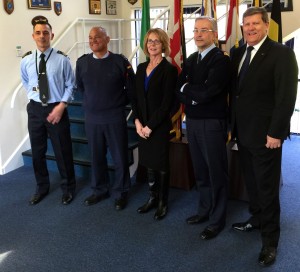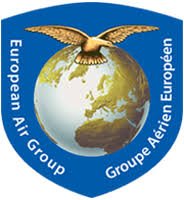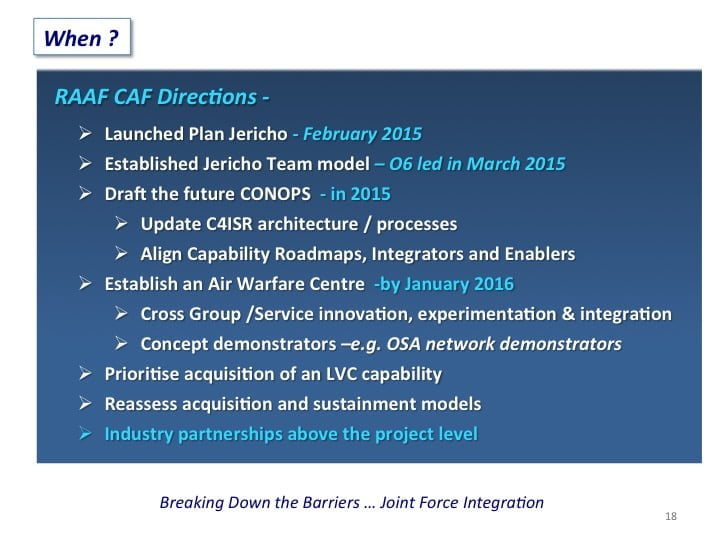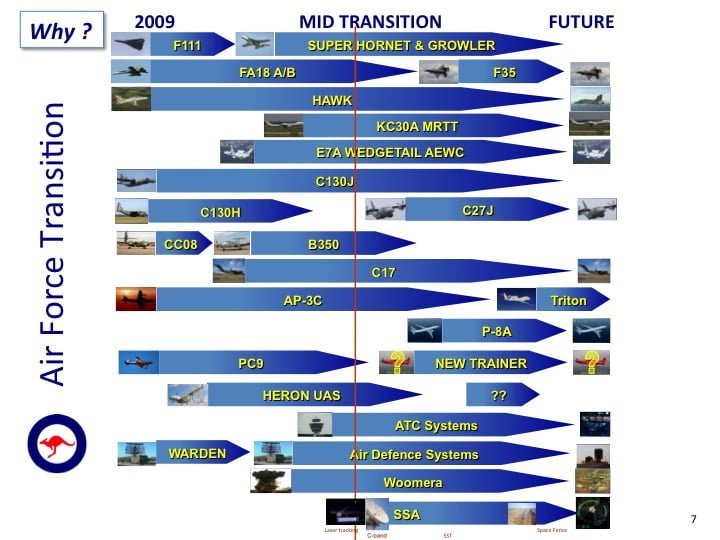2015-04-29 John Blackburn retired as an Air Vice-Marshal in the Royal Australian Air Force in 2008 and has been involved in a number of strategic issues since then in Australia.
He is currently the Deputy Chairman of the Sir Richard Williams Foundation, an Australian think tank focused on Air Power. In his Reservist capacity, he was tasked by the current Chief of Staff of the RAAF, Air Marshal Geoff Brown, to help standup what Brown calls Plan Jericho.
He has worked on this effort for the past 12 months, and the Plan has been launched and even more importantly the process to achieve a transformation.
As Blackburn explained at the Copenhagen Airpower Symposium on April 17, 2015, the idea behind the effort is pretty straightforward, namely, to leverage the coming of the F-35 as a trigger for transformation for the modernizing RAAF fleet.
Rather than just waiting for the coming of a fifth generation aircraft, the Aussies are looking to reshape the force to become a more integrated, lethal force enabled by vastly improved, shared, situational awareness and targeted decision making able to operate effectively in the challenging environments in which they operate. It is about a step change in the ability to operate as an integrated team across the Australian Defence Force and in Coalition operations.
The RAAF considers the F-35 in the terms, which Lt. Col. Berke has described, an entirely new type of aircraft, but its impact comes not simply from being a new type of aircraft but providing enhanced situational awareness, decision-making and spectrum dominance.
And the full value of the plane simply will not come by operating by itself as some sort of silver bullet, but operating in an effective manner with the other new platforms and with legacy systems which are themselves becoming shaped for 21st century operations.
In part, the challenge is to get past the replacement platform mentality.
The core air platforms have been or are being replaced but the task is not simply to learn the new platform and prepare for the next one in a narrowly defined functional area – fighter is a fighter, tanker is a tanker, a lifter is a lifter, an air battle manager is an air battle manger and so on down the 20th century species list – but to shape cross platform capabilities and to reshape how battle management, operations and warfare is conducted.
This is challenging for a small air force, which is already taxed in learning how to operate new platforms, and get them into operations.
The notion of preparing for the introduction of the F-35 and cross platform innovation will be evolved by testing new approaches to using other new platforms and leveraging them as well in new ways PRIOR to the F-35 becoming the dominant fighter in the RAAF.
For example, the RAAF Super Hornets operating in the Middle East have changed aspects of how they operate as they worked with F-22s in operations.

Or, the Wedgetail is an innovation battle management platform, but it is not about simply providing a 21st century upgrade on AWACS it is about managing the battlespace differently with various domains in operations, and testing ways to do battle management differently with the KC-30A tanker and the Hornets and Super Hornets.
They aim to find ways to shape distributed operational capabilities before the F-35 a trigger for a new model of 21st century distributed operations.
It is not about waiting for change to occur; it is about transforming with the coming of the trigger force, the F-35, and other key elements as well such as the Triton.
At the heart of the challenge is to shape a narrative, which gains wide acceptance in the Australian Defence Force and resonates with the public.
It is not about adding silver bullet capability for future fights.
Shaping a fifth generation warfare narrative and driving transformation are closely connected.
The narrative is not just an abstraction but describes a universe of innovation populated by cross-platform transformation.
The Chief of the RAAF starts with underscoring how the F-35 impacts on the pilots.
He has identified the following 5th Gen Implications for the pilot:
Sensors require little if any manual manipulation;
Fused picture is presented to the pilot on a single display;
Inter-flight comm is significantly reduced;
Pilot has more brain-space to be a tactician rather than a sensor operator and data fuser
Faster and more accurate decisions
Massive generational leap in Situational Awareness
Ability to forward plan and allocate resources pre-emptively.
He then moves from this and asks about its implications then for the force:
In particular, “the Chief has focused on the 5th Gen Implications for Air Battle Management and has concluded:
- We need a generational change in the ISR, network and Comms systems and other capabilities that will support the F-35 is we are to get the most out of the aircraft’s capabilities …
- We must continue to think about and analyze how we employ all of our air combat systems as a system of systems in our regional security setting and within the rapidly changing technological environment.”
For Air Marshal Brown, the task for Plan Jericho is about combat innovation and not just about a new airplane, but what that plane and the innovation in the RAAF associated with the plane might mean for the Australian Navy and Army as well?
The question he posed to launch Plan Jericho is simply: What is a 5th Gen / 5th Gen enabled Force?
For the Chief this is clearly a Force with: vastly improved shared situational awareness, the ability to operate as an integrated team and the term is a lever for joint integration in 21st century combat conditions and adapted to a 21st century strategic environment.”
The formal definition of Plan Jericho has been laid out in an official publication earlier this year and the way to understand it is as follows:
“Plan Jericho is Air Force’s plan to transform into a fully integrated force that is capable of fighting and winning in the information age.
Jericho Vision: To develop a future force that is agile and adaptive, fully immersed in the information age, and truly joint.
This is not the final plan, but rather the first step to meet our challenge of transformation for the future.
In many ways, the ecosystem which synergistically interacts with the coming and evolution of the F-35 global fleet (as Lt. Col. Berke put it) is what plan Jericho is all about: how do we create an effective 21st century combat ecosystem leveraging the F-35 but within which the other platforms find their proper place in a reset or transformed combat force?
The Dutch Air Force focuses on Air Force 3.0; the Marines on the F-35 reshaping the MAGTF, and the Aussies have launched Project Jericho.
It is not simply about buying a replacement aircraft.
It is about changing the mental furniture and reshaping the way the force operates.
This is easier said than done, something Blackburn is acutely aware of having been part of earlier RAAF processes of change.
The focus cannot be simply on top down directives or change, or simply having a transformation office handing out mandates for change.
It has to come from the 06 and O5 leaders and it needs to come from the operators and not just the self-styled strategic thinkers.

It is about unblocking opportunities, which can be found throughout the force; it can come only from the rising generation committing themselves to change and shepherding change throughout the RAAF. It is about defining a vector rather than a detailed plan.
To do so, the Jericho team has been established with two 06s or Colonels who are working the relationships within the RAAF and across the Australian Defence Force to support the Chief’s approach.
They have been pulled from operational responsibilities for a period as co-chairs of the effort, and given time to talk to others in the RAAF and to think.
And to assist in the effort, a new Air Warfare Centre is being established to facilitate dialogue on practical opportunities for innovation and change, in part along the lines of the RAF Air Warfare Centre, which means its is about combat operations as much as it is about pure airpower innovation.
Not surprisingly, when the RAAF searched for innovative thinking from allies and industry, not a lot has been easily found.
So the effort itself will need to trigger that kind of change.
In part, that is why Blackburn and the Williams Foundation were in Copenhagen to drive the debate about the future of airpower, and to be able to present with the core partner whom they recognize as going through a very similar thought process, namely the USMC.
To shape a way ahead, Blackburn discussed a four-part process, which is highly overlapping and highly interactive.
The first step is to develop a fifth generation “narrative” to explain the opportunity that the JSF provides as a basis for a 5th generation enabled force concept.
The second step is develop a high level 5th generating enabled air operations architecture with concrete examples for fifth generation concepts of operations, for example a new approach to air battle management.
The third step is to develop individual capability roadmaps based on existing plans that will identify gaps and disconnects with a 5th generation concept of operations.
The fourth step is to identify critical joint integrators and enablers; to identify impact s of delays to integrators and enablers on fifth generational capability and to prioritize integrators and enablers based on capability impacts.
It is clear that the RAAF is providing an innovative challenge to allied air forces, and clearly will be a lever for change across the Pacific, in the United States, Europe and the Middle East.
And certainly the standing up of the global F-35 fleet will provide an important opportunity for proliferating the RAAF innovation effort.
Editor’s Note: John Blackburn visited the RAF and the European Air Group while in England prior to the Copenhagen Airpower Symposium.






